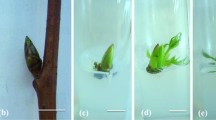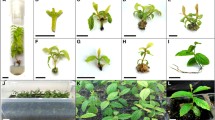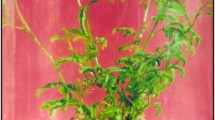Abstract
We developed a method for in vitro regeneration of Garcinia xanthochymus (yellow mangosteen) from matured seed segments. Multiple shoots were induced on woody plant (WP) medium supplemented with cytokinins. An average of 11 shoots per explant were regenerated from mature seed segments on WP medium containing 20 µM 6-benzylaminopurine. Histological analysis revealed that hypodermal cells of seed segments were initially involved in active division, which later developed into meristemoids, subsequently leading to the formation of shoot buds. Shoot elongation was achieved by repeated subculturing of seed explants in shoot regeneration medium. Rooting of shoots was achieved on WP medium supplemented with indole-3-butyric acid or α-naphthalene acetic acid. Plantlets were transplanted to pots containing soil: compost (1:1) and survival rate was 90 %.
Similar content being viewed by others
Avoid common mistakes on your manuscript.
Introduction
Yellow mangosteen or ‘false mangosteen’ or ‘gamboge’ (Garcinia xanthochymus Hook. f. T. Anderson) is a fruit tree which is native to India distributed in the Eastern Himalayas and Western Ghats region. The fruit is rich in hydroxycitric acid, which is valued for health benefits. The fruits are also used in jams, preservatives and in vinegar (Facciola 1998). Gamboge is used in water colors and as a yellow fabric dye (Mabberly 1993). Mature trees of yellow mangosteen are also harvested for use as timber. Various benzophenones have been isolated from G. xanthochymus that have biological activities against colon cancer cell lines (Baggett et al. 2005). Propagation of yellow mangosteen is through seeds which have short shelf life and propagation through softwood grafting is not successful. In vitro propagation is an effective method for rapid propagation of species in which conventional methods have limitations. Micropropagated planting stock is useful for re-forestation programmes, gardening and the conservation of germplasm. In vitro plant regeneration has been accomplished for many tree species including Feronia limonia (Hiregoudar et al. 2003), Vitex trifolia (Hiregoudar et al. 2006), Salix pseudolasiogyne (Park et al. 2008), Garcinia indica (Baskaran and Krishnan 2011; Deodhar et al. 2008; Thengane et al. 2006; Malik et al. 2005), Garcinia mangostana (Goh et al. 1990; Huang et al. 2000).
The objective of this study was to develop an effective regeneration system for G. xanthochymus. We describe here the experiments performed for successful micropropagation of yellow mangosteen using immature seed explants. To our knowledge, this is the first report of in vitro regeneration of G. xanthochymus. The micropropagated plants can help to meet the increased demand for yellow mangosteen tree for gardening and timber production.
Materials and methods
Plant material, culture medium and conditions
Ripened fruits of yellow mangosteen (Fig. 1a) were collected from Sirsi, Karnataka India. Seeds were separated from the pulp and washed thoroughly in water. The decoated seeds were rinsed in 70 % (v/v) alcohol and then surface sterilized with 0.1 % mercuric chloride for 5 min followed by thorough rinsing in sterile distilled water 3–4 times. The seeds were cut into two or four pieces and were cultured on woody plant medium (WPM; Lloyd and McCrown 1980) supplemented with 2 % (w/v) sucrose and with 1.0, 5.0, 10.0, 15.0 and 20.0 µM 6-benzylaminopurine (BAP) or kinetin (KN) or thidiazuron (TDZ); Table 1). Seed segments involved in shoot regeneration were subcultured on-to a fresh culture medium once in 4 weeks. For rooting of shoots, the shoots were subcultured on WPM containing 2 % (w/v) sucrose and 1.0, 2.0, 5.0 and 10.0 µM indole-3-butryric acid (IBA) or indole-3-acetic acid (IAA) or α-naphthalene acetic acid (NAA). The pH of all the media was adjusted to 5.8 prior to autoclaving (20 min at 121 °C; 1.4 × 104 kg m−2) and solidified using agar (0.8 % agar, w/v). Culture tubes (25 mm × 150 mm) and culture bottles (500 mL) were prepared with 20 and 50 mL media respectively. All growth regulators and agar were obtained from Duchefa, The Netherlands. Medium without plant growth regulators was used as control. Cultures were incubated in a growth chamber at (25 ± 1) °C, with a 16 h photoperiod (40 µmol m−2 s−1) provided by 40-W fluorescent lamps (Philips, Kolkata, India).
Micropropagation of yellow mangosteen from mature seed explants. a is Fruits of Garcinia xanthochymus (bar 2.5 cm); b is Shoot buds developed on seed segments cultured on WP medium with 20 µM BAP (bar 1.33 cm); c is Multiple shoots developed from seed explants cultured on WP medium supplemented with 20 µM BAP (bar 1.33 cm); d is Well developed shoot (bar 1.88 cm); e is Roots developed from shoot on WP medium supplemented with 5 µM NAA (bar 1.13 cm); f is Plant transferred to pot containing soil and compost (bar 1.29 cm)
Acclimatization of plants, histology and statistical analysis
In vitro regenerated plantlets were transferred to pots (30 cm diameter) containing soil and compost (1:1) and were maintained in a plant growth chamber (Sanyo, Osaka, Japan) at 25 °C, 60 % relative humidity, with a 16-h photoperiod (40 µ mol m−2 s−1) provided by 40-W fluorescent lamps. After 2 weeks, the plantlets were transferred to larger pots (50 cm diameter) containing soil and compost (1:1) and maintained in the greenhouse.
Histology
For histological studies, fresh explants as well as the responding explants after 1, 2, 3 and 4 weeks of culture were fixed in FAA (Formalin: acetic acid: absolute alcohol; 2: 1: 17, v/v) for 24-h, dehydrated in a series of alcohol grades, and then embedded in paraffin. Serial Sects. (8 µM thickness) were cut and stained with 0.1 % toluidine blue. The sections were observed and photographed under appropriate magnifications using a Leica DRMB microscope.
Statistical analysis
Ten replicates were maintained for each treatment. Results were analyzed by SPSS 17.0 for MS Windows (SPSS Inc.), using analysis of variance (ANOVA). The mean values were calculated and compared according to Duncan’s multiple range test at P ≤ 0.05 levels.
Results and discussion
Seed segments cultured on cytokinin-supplemented medium swelled and turned yellow to green in color by 4 weeks of culture, and developed adventitious shoot buds at the cut portion as well as on the surface (Fig. 1b). These shoot buds developed into shoots in another 2–4 weeks of culture (Fig. 1c). Malik et al. (2005), Baskaran and Krishnan (2011) observed similar response of swelling of seed explants along with shoot bud differentiation on the medium supplemented with growth regulators in G. indica. Development of somatic embryos was reported by Thengane et al. (2006) on immature seed explants of G. indica. The effect of cytokinins on seed explants of G. xanthochymus is summarized in Table 1. Medium supplemented with BAP was found superior in induction of multiple shoots from seed explants (Fig. 1c). 80 % of seed explants developed 1–3 shoots on the medium supplemented with 1, 5 and 10 µM BAP (Table 1). All the cultured seed segments (100 %) responded on the medium supplemented with 15 and 20 µM BAP (Table 1), however, medium with 20 µM BAP proved superior in induction of shoot buds and a maximum of 11 shoot buds per explant was developed on this medium. 80–100 % of explants developed 1–3 shoots on medium supplemented with KN, whereas TDZ-supplemented medium was not beneficial in shoot bud differentiation and explants remained green even after subculturing to fresh medium. The superiority of BAP on shoot bud induction was previously reported for G. mangostana (Goh et al. 1990; Huang et al. 2000) and G. indica (Malik et al. 2005; Baskaran and Krishnan 2011). Similar effect of BAP in inducing multiple shoots has been reported for tree species such as F. limonia (Hiregoudar et al. 2003), V. trifolia (Hiregoudar et al. 2006) and Salix pseudolasigyne (Park et al. 2008).
Histological preparation of responding explants revealed that hypodermal parenchymatous cells (Fig. 2a) were involved in active division (Fig. 2b) after 1 week of culture. Such active cell division led to the development of meristematic zones after 2 weeks of culture (Fig. 2c). Further, these meristematic zones organized themselves to develop into shoot buds in another 1 or 2 weeks of culture (Fig. 2d).
Histological studies of shoot development from seed explants on WP medium supplemented with 20 µM BAP. a is Longitudinal section of explant showing uniform parenchymatous cells in the hypodermal region (bar 0.037 cm); b is Longitudinal section of explants showing active cell division of parenchymatous cells after 1 week of culture (bar 0.025 cm); c is Longitudinal section of explants showing meristemoids developed in hypodermal region of explant after 2 weeks of culture (bar 0.018 cm); d is Longitudinal section of explants showing meristemoid developing into shoot primordium after 3 weeks of culture (bar 0.025 cm)
Explants with induced shoots were subcultured onto the same shoot induction medium for shoot elongation. Maximum shoot length of 6.08 cm was observed on the medium supplemented with 5 µM BAP (Fig. 1d). The elongated shoots were excised and the explants were cultured again onto fresh medium for elongation of the remaining shoots. Baskaran and Krishnan (2011) reported that removal of the elongated shoots at regular intervals was necessary to enable the elongation of smaller shoots in G. indica.
Shoots regenerated on medium supplemented with 20 µM BAP were harvested onto WP medium supplemented with auxins (Table 2). 70–80 % of rooting was observed after 4 weeks of culture on medium supplemented with IBA and NAA. Medium supplemented with NAA induced the highest number of roots (3–5 per explants) at 5 µM concentration (Table 2; Fig. 1e). Shoots cultured on basal medium and medium supplemented with IAA did not develop roots. Similar responses of root induction by NAA and IBA were reported for G. indica (Malik et al. 2005; Thengane et al. 2006; Deodhar et al. 2008) and G. mangostana (Goh et al. 1990). The in vitro raised plantlets were transplanted to pots containing soil and compost (1:1) and were maintained in a plant growth chamber under the controlled environment for 2 weeks. The plantlets showed a 90 % survival rate. After 2 weeks of growth, plants were transferred to bigger pots and reared in green house (Fig. 1f).
In vitro culture techniques are an important aid for multiplication of economic tree species that whose conventional propagation is limited. The method for in vitro propagation of yellow mangosteen (G. xanthochymus), is a simple and practical method for large scale propagation. This protocol can be efficiently used for the production of elite clones for large scale cultivation.
Abbreviations
- BAP:
-
6-benzylaminopurine
- IAA:
-
Indole-acetic acid
- IBA:
-
Indole-3-butyric acid
- KN:
-
Kinetin
- NAA:
-
α-Naphthalene acetic acid
- TDZ:
-
Thidiazuron
- WP:
-
Woody plant medium
References
Baggett S, Protiva P, Mazzola EP, Yang H, Ressler ET, Basile MJ, Weinstein IB, Kennelly EJ (2005) Bioactive benzophenones from Garcinia xanthochymus fruits. J Nat Prod 68(3):354–360
Baskaran M, Krishnan S (2011) High frequency plant regeneration from the mature seeds of Garcinia indica. Biol Plant 55(3):554–558
Deodhar SR, Thengane RJ, Thengane SR (2008) De nova shoot regeneration from root culture of Garcinia indica Choiss. Indian J Exp Biol 46(6):482–486
Facciola S (1998) Cornucopia II: a source book of edible plants. Kampong Publications, California, p 79
Goh HKL, Rao AN, Loh CS (1990) Direct shoot bud formation from leaf explant of seedlings and mature mangosteen (Garcinia mangostana L.) trees. Plant Sci 68(1):113–121
Hiregoudar LV, Murthy HN, Hema BP, Hahn EJ, Paek KY (2003) Multiple shoot induction and plant regeneration of Feronia limonia (L.) Swingle. Sci Hortic 98(4):357–364
Hiregoudar LV, Murthy HN, Bhat JG, Nayeem A, Hema BP, Hahn EJ, Paek KY (2006) Rapid clonal propagation of Vitex trifolia. Biol Plant 50(2):291–294
Huang LC, Huang BL, Wang CH, Kuo CI, Murashige T (2000) Developing improved in vitro propagation system for slow-growing species using Garcinia mangostana L. (mangosteen). In Vitro Cell Dev Biol Plant 36:501–504
Lloyd GB, McCrown BH (1980) Commercially feasible micropropagation of mountain laurel Kalmia latifolia by use of shoot tip culture. Comb Proc Int Plant Propag Soc 30:412–427
Mabberly DJ (1993) The plant book: a portable dictionary of the higher plants. Cambridge University Press, New York, p 236
Malik SK, Chaudhury R, Kalia RK (2005) Rapid in vitro multiplication and conservation of Garcinia indica: a tropical medicinal tree species. Sci Hortic 106(4):519–523
Park SY, Kim YW, Moon HK, Murthy HN, Choi YH, Cho HM (2008) Micropropagation of Salix pseudolasiogyne from nodal explants. Plant Cell Tissue Organ Cult 93(3):341–346
Thengane SR, Deodhar SR, Bhosle SV, Rawal SK (2006) Direct somatic embryogenesis and plant regeneration in Garcinia indica Choisy. Curr Sci 91(8):1074–1078
Author information
Authors and Affiliations
Corresponding author
Additional information
Project funding: This study is supported by University Grants Commission [Project no. F. No. 41-423/2012 (SR)], Department of Biotechnology (DBT-KUD-IPLS programme BT/PR14555/INF/22/126/2010), New Delhi and Department of Atomic Energy (BRNS project no. 2013/35/BRNS/20) Mumbai, India.
The online version is available at http://www.springerlink.com
Corresponding editor: Zhu Hong
Rights and permissions
About this article
Cite this article
Patil, L.M., Murthy, H.N., Dandin, V.S. et al. Micropropagation of yellow mangosteen: a valuable endemic tree of India. J. For. Res. 27, 161–165 (2016). https://doi.org/10.1007/s11676-015-0102-4
Received:
Accepted:
Published:
Issue Date:
DOI: https://doi.org/10.1007/s11676-015-0102-4






